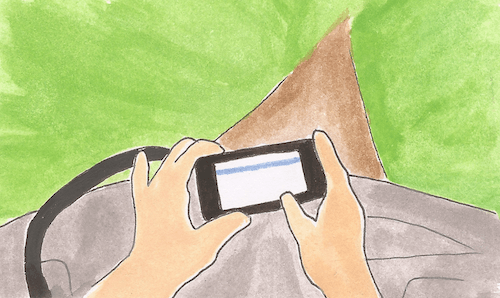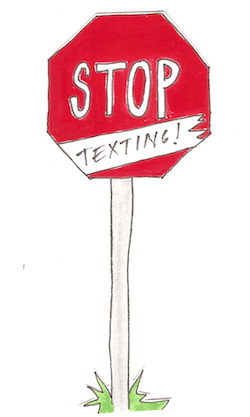By Sarah Jane Quillin
It takes only a brief look around in a crowded public space to observe the intimate relationship we have with our mobile phones. While texting services in the US went relatively unused during their inception 20 years ago, today text messaging is the most widely used mobile data service and has become a worldwide cultural phenomenon [1]. Over the past decade, as texting became part of the daily lives of many Americans, texting and driving became a public health epidemic. While the question of why drivers do not wait to send or answer a text message is better left to the field of behavioral psychology, the question of how to prevent fatalities caused by drivers who text is one for public health officials, advocates, and researchers.
Primary research suggests that texting and driving is, by far, the most dangerous of a larger subset of distracted driving activities. A 2009 Virginia Tech Transportation Institute naturalistic study, using kinematic observations of real drivers captured on videotape, is the main source of this data. Results showed that drivers were 23 times more likely to crash when texting than when not texting [6]. This number can be compared to drivers who were 6 times more likely to crash when dialing a phone call and 6.7 times more likely when reaching for a phone, while no observable risk was found for talking or listening to a cell phone. The likely reason behind the high danger associated with texting is the length of time a text draws the driver’s eyes away from the road. In the Virginia Tech study, texting took the driver’s eyes off the road for an average of 4.6 seconds [6]. At 55 miles per hour, this equates to driving the length of a football field blind.
Texting has resulted in an increasing number of motor vehicle casualties in recent years. From 2011 to 2012, injuries associated with distracted driving increased by nearly 9%, despite an overall decline in the total number of motor vehicle accidents [2]. Of the total number of car crashes each year, the National Safety Council estimates that 100,000 additional crashes are caused by texting behind the wheel [3]. In 2011 the number of fatalities from distracted driving-related crashes totaled 3,328, with all being preventable deaths. Public health intervention is desperately needed to stop drivers who text because the problem is only expected to increase. In 2011, Americans sent 50% more texts than just three years prior, with 196 billion texts sent that year [4]. As the majority of mobile phone users that text daily are under the age of 34, it is predicted that as the population ages the number of people texting will continue to increase [5]. An increase in texting, coupled with an increase in the percentage of the population who text, may result in even more drivers who endanger the public by texting behind the wheel.
Efforts are underway to prevent further casualties. In the past decade, legislation against mobile phone use while driving has passed relatively quietly compared to similar public health legislation campaigns like seatbelt laws or laws designed to curtail tobacco use. While seatbelt laws have been opposed by those who argue the laws infringe on individual freedom, and tobacco taxes have been stymied in the commercial interest of tobacco companies, virtually no one is championing the right to text and drive. As of 2012, 39 states and the District of Columbia (DC) prohibit drivers from texting, 32 states and DC prohibit novice drivers from cell phone use, and 10 states and DC prohibit hand-held cell phone use by drivers [7]. The effectiveness of such legislation, however, is controversial [8, 9]. While existing laws set a foundation to prevent texting and driving, law enforcement on the ground lack the resources and technology to detect drivers who text before an accident occurs. As such, public health media campaigns are being implemented to educate drivers of the risks and implications of the decision to text behind the wheel.
Campaigns sponsored by mobile phone providers, the National Department of Transportation, the Centers for Disease Control and Prevention, and local public health institutions use different forms of media to educate the public on how dangerous it is to text and drive. In Chicago, an electronic billboard over the I-94 Expressway reads “1002 TRAFFIC DEATHS 2013 DON’T TEXT AND DRIVE.” The most prominent national campaign utilizes the slogan, “It Can Wait,” and seeks to make the problem of texting and driving as visible and unacceptable as driving while intoxicated [10]. The It Can Wait campaign is spearheaded by the AT&T service provider, and drivers who take a pledge to never text and drive then share this pledge across social media. It Can Wait advertises “The Last Text,” across television and print media, displaying the kinds of texts that have preceded accidents, causing viewers to confront the non-urgency of their text messages. The It Can Wait campaign sponsored a short film, “From One Second to the Next,” by documentarian Werner Herzog that links four personal stories to the texting and driving epidemic in America. Herzog’s subjects belong to both sides; some are the victims of an automobile tragedy caused by texting, some are drivers who live with the deep repercussions of the choice to text and drive. All come together to deliver the same message to viewers: It can wait.
History has taught public health scholars and officials that legislation and education alone are often not enough to make populations change their behavior. There is still a need for research into demographics most likely to text and drive, and development of technology to prevent drivers from texting. In 2012, the problem was reportedly worse with those drivers under the age of 20, with teens admitting more likelihood to text and drive in national surveys [11]. AT&T has developed DriveMode, a mobile app available on Android and Blackberry models, that sends automatic replies to texts and emails while the driver is on the road. The company also tours 380 national events annually with a virtual texting and driving simulator, designed to show participants how difficult it is for a person to text while driving responsibly; the simulator is also currently available online [12]. With education campaigns becoming more widespread and the It Can Wait campaign gaining widespread third party support, it is likely that the coming years will see more development of technology to both detect and prevent drivers who text.
The problem of texting and driving is being addressed on many public health fronts: legislation, education, research, and technological development. Still, at this juncture, as many as 75% of teens say that texting and driving is “common” amongst their friends [10]. One can advocate by taking the pledge to not text and drive at www.itcanwait.com/getinvolved and sharing the pledge across social media, or downloading an activation kit that prints texting and driving facts and posters for display in public spaces. Increased individual and institutional advocacy for anti-texting and driving campaigns are current ways in which public health-minded individuals and institutions are attempting to stop further preventable deaths and injuries.
References
- Shannon, V., 15 years of text messages, a ‘cultural phenomenon’. The New York Times, 2007.
- National Highway Traffic Safety Administration, Facts and Statistics, accessed 26 November 2013: http://www.distraction.gov/content/get-the-facts/ facts-and-statistics.html
- Lane K, National Safety Council Estimates that At Least 1.6 Million Crashes Each Year Involve Drivers Using Cell Phones and Texting. National Safety Council, Attributable Risk Estimate Model, 2010.
- National Highway Traffic Safety Administration, Facts and Statistics. Posted by the Centers for Disease Pre- vention and Control May 23, 2012: http://www.cdc.gov/motorvehiclesafety/distracted_driving/
- Hallquist, T., Driver Distraction in Commercial Vehicle Operations. US Department of Transportation, Webinar Transcript 2009.
- Olson R.L., Hanowski R.J., et. al. Driver distraction in commercial vehicle operations. September 2009. (Report No. FMCSA-RRR-09-042) Information avail- able readily in Virginia Tech press release July 27, 2009, by Sherri Box: New Data from VTTI Provides Insight into Cell Phone Use and Driving Distraction.
- Information cited to Governors Highway Safety Association, Cell Phone and Texting Laws, June 2012. http://www.textinganddrivingsafety.com/tex ting-nd-driving-stats/,
- Coben, J.H. and M. Zhu, Keeping an eye on distracted driving. JAMA, 2013. 309(9): p. 877–‐8.
- Teater, D.D., Dangers of distracted driving. JAMA, 2013. 309(23): p. 2436.
- It Can Wait Campaign AT&T Fact Sheet, 2014. www. itcanwait.com
- Information cited to National Highway Traffic Safety Administration, press release 2012. http://www. textinganddrivingsafety.com/texting-and-driv ing-stats/
- http://www.itcanwaitsimulator.org/
About the Author
Sarah Jane Quillin is a PhD/MPH student studying microbiology in Dr. Hank Seifert’s lab. Her research interests are infectious disease epidemiology, antibiotic resistance, and the way laboratory research affects public health policy. In addition, Sarah is interested in the way emerging technologies contribute to evolving public health issues.


